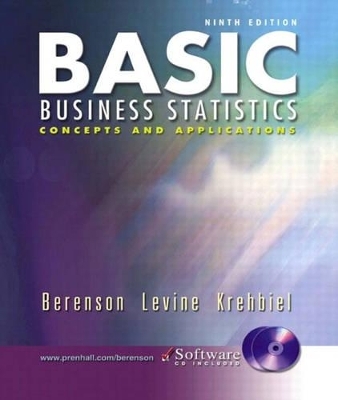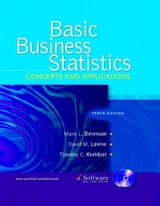
Basic Business Statistics and Student CD-ROM
Pearson
978-0-13-103791-5 (ISBN)
- Titel erscheint in neuer Auflage
- Artikel merken
This comprehensive 18 chapter text focuses on the underlying statistical concepts that are important to students majoring in business. The authors take an applied approach and relate the concepts and applications of statistics to the functional areas of business-accounting, marketing, management, and economics and finance. This text also emphasizes the proper use of statistics to analyze data and assumes that computer software is an integral part of this analysis. Excel and Minitab, and now SPSS® are featured.
1. Introduction and Data Collection.
Overview of Statistics. Applying Statistics to Business. How This Text Is Organized. The Importance of Collecting Data. Identifying Sources of Data. Design of Survey Research. Types of Survey Sampling Methods. Types of Data. Evaluating Survey Worthiness.
2. Presenting Data in Tables and Charts.
Organizing Numerical Data. Tables and Charts for Numerical Data. Graphing Bivariate Numerical Data. Tables and Charts for Categorical Data. Tabulating and Graphing Bivariate Categorical Data. Graphical Excellence.
3. Numerical Descriptive Measures.
Exploring Numerical Data and Their Properties. Measures of Central Tendency, Variation, and Shape. Obtaining Descriptive Summary Measures from a Population. Obtaining Descriptive Summary Measures from a Frequency Distribution. Exploratory Data Analysis. The Coefficient of Correlation. Pitfalls in Numerical Descriptive Measures and Ethical Issues.
4. Basic Probability.
Basic Probability Concepts. Conditional Probability. Bayes' Theorem. Counting Rules. Ethical Issues and Probability.
5. Some Important Discrete Probability Distributions.
The Probability Distribution for a Discrete Random Variable. Covariance and Its Application in Finance. Binomial Distribution. Hypergeometric Distribution. Poisson Distribution. CD ROM Topic Using the Poisson Distribution to Approximate the Binomial Distribution.
6. The Normal Distribution and Other Continuous Distributions.
The Normal Distribution. Evaluating the Normality Assumption. The Uniform Distribution. The Exponential Distribution. CD ROM Topic The Normal Approximation to the Binomial Distribution.
7. Sampling Distributions.
Sampling Distribution of the Mean. Sampling Distribution of the Proportion. CD ROM Topic Sampling from Finite Populations.
8. Confidence Interval Estimation.
Confidence Interval Estimation of the Mean (s Known). Confidence Interval Estimation of the Mean (s Unknown). Confidence Interval Estimation for the Proportion. Determining Sample Size. Applications of Confidence Interval Estimation in Auditing. Confidence Interval Estimation and Ethical Issues. CD ROM Topic Estimation and Sample Size Determination for Finite.
9. Fundamentals of Hypothesis Testing: One-Sample Tests.
Hypothesis-Testing Methodology. Z Test of Hypothesis for the Mean (s Known). One-Tailed Tests. t Test of Hypothesis for the Mean (s Unknown). Z Test of Hypothesis for the Proportion. x2 Test of Hypothesis for the Variance or Standard Deviation. Potential Hypothesis-Testing Pitfalls and Ethical Issues. CD ROM Topic The Power of a Test.
10. Two Sample Tests with Numerical Data.
Comparing Two Independent Samples: Tests for Differences in Two Means. F Test for Differences in Two Variances. Comparing Two Related Samples: Tests for the Mean Difference. Wilcoxon Rank Sum Test: Nonparametric Analysis for Two Independent Populations. Wilcoxon Signed-Ranks Test: Nonparametric Analysis for Two Related Populations.
11. Analysis of Variance.
The Completely Randomized Design: One-Way Analysis of Variance. The Randomized Block Design. The Factorial Design: Two-Way Analysis of Variance. Kruskal-Wallis Rank Test: Nonparametric Analysis for the One-Way Design. Friedman Rank Test: Nonparametric Analysis for the Randomized Block Design.
12. Tests for Two or More Samples with Categorical Data.
Z Test for the Difference between Two Proportions. Chi-Square Test for Differences between Two Proportions. Chi-Square Test for Differences in Among More than Two Proportions. Chi-Square Test of Independence. CD ROM Topic Chi-Square Goodness of Fit Tests.
13. Simple Linear Regression.
Types of Regression Models. Determining the Simple Linear Regression Equation. Measures of Variation. Assumptions. Residual Analysis. Measuring Autocorrelation: The Durbin-Watson Statistic. Inferences about the Slope and Correlation Coefficient. Estimation of Predicted Values. Pitfalls in Regression and Ethical Issues. Computations in Simple Linear Regression.
14. Introduction to Multiple Regression.
Developing the Multiple Regression Model. Residual Analysis for the Multiple Regression Model. Testing for the Significance of the Multiple Regression Model. Inferences Concerning the Population Regression Coefficients. Testing Portions of the Multiple Regression Model. Using Dummy-Variables and Interaction Terms in Regression Models. Introduction to Logistic Regression.
15. Multiple Regression Model Building.
The Quadratic Regression Model. Using Transformations in Regression Models. Influence Analysis. Collinearity. Model Building. Pitfalls in Multiple Regression and Ethical Issues.
16. Time-Series Analysis.
The Importance of Business Forecasting. Component Factors of the Classical Multiplicative Time-Series Model. Smoothing the Annual Time Series. Least-Squares Trend Fitting and Forecasting. The Holt-Winters Method for Trend Fitting and Forecasting. Autoregressive Modeling for Trend Fitting and Forecasting. Choosing an Appropriate Forecasting Model. Time-Series Forecasting of Monthly or Quarterly Data. Index Numbers. Pitfalls Concerning Time-Series Analysis.
17. Decision Making.
Payoff Tables and Decision Trees. Criteria for Decision Making. Decision Making with Sample Information. Utility.
18. Statistical Applications in Quality and Productivity Management.
Total Quality Management. Six Sigma® Management. The Theory of Control Charts. Control Chart for the Proportion of Nonconforming Items—The p Chart. The Red Bead Experiment: Understanding Process Variability. The c Chart. Control Charts for the Range and the Mean. Process Capability.
| Erscheint lt. Verlag | 3.4.2003 |
|---|---|
| Sprache | englisch |
| Themenwelt | Mathematik / Informatik ► Mathematik ► Finanz- / Wirtschaftsmathematik |
| Mathematik / Informatik ► Mathematik ► Statistik | |
| ISBN-10 | 0-13-103791-9 / 0131037919 |
| ISBN-13 | 978-0-13-103791-5 / 9780131037915 |
| Zustand | Neuware |
| Haben Sie eine Frage zum Produkt? |
aus dem Bereich



